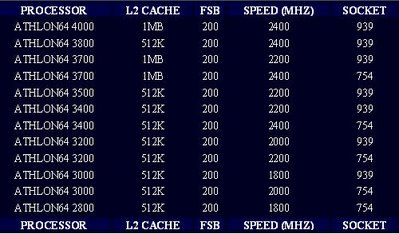Which is your favourite race in AT?
Thursday, December 28, 2006
Wednesday, December 27, 2006
AMD PROCESSOR CHART
AMD ATHLON64 FX PROCESSOR CHART
"The AMD Athlon™ 64 FX processor features innovative technology to provide extraordinary performance and a gaming experience without parallel. The AMD Athlon 64 FX processor runs on AMD64 Technology, a revolutionary technology that 1) allows the processor to run 32-bit applications at full speed while enabling the coming wave of powerful, 64-bit software applications, and 2) provides Enhanced Virus Protection when supported by the OS*. AMD64 technology shatters barriers to new and advanced software that require 64-bit technology and blazing processor performance. Power-hungry enthusiasts and gamers can explore the full potential of AMD64 technology while enjoying outstanding performance on today's PC software."
AMD ATHLON64 X2 DUAL CORE PROCESSOR CHART
"Frustrated by staring at the hourglass icon as soon as you try to work on more than three programs at once, especially when you’re working with digital media? Increase your performance by up to 80% with the AMD Athlon™ 64 X2 dual core processor. Work or play with multiple programs without any stalling or waiting. Dual-core technology is like having two processors, and two working together is better and faster than one working alone."
AMD ATHLON64 PROCESSOR CHART
"AMD's Athlon 64 is the latest evolution in the desktop computer industry. With its revolutionary 64bit architecture this CPU is fully compatible with future 64 bit operating systems and offers blistering performance in current 32 bit applications. With AMD's new HyperTransport technology and a massive 512kb L2 cache."
AMD SEMPRON PROCESSOR CHART
"AMD Sempron processors for desktop and mobile products offer best in class performance, compatibility with all the applications you need, and the reliability of AMD processors. Best-in-class performance for everyday computing. The AMD Sempron™ processor performs at the top of its class when running the home and business applications that you need most. Full-featured to improve your computing experience. The AMD Sempron™ processor lets you enjoy a dynamic Internet experience with smooth streaming video and audio." 
Tuesday, December 26, 2006
Release Dates of World of Warcraft

November 12, 2004
Korea
November 23, 2004
USA, Canada, Australia, New Zealand, Mexico
February 11, 2005
European Union
June 6, 2005
China
July 21, 2005
Singapore
November 8, 2005
Taiwan, Hong Kong, Macau
August 1, 2006
South Africa
History of Real Time Strategy (RTS)

1983 – 1992: the beginning
In the UK, the genre's beginning can be traced to Stonkers by John Gibson, published in 1983 by Imagine Software for the ZX Spectrum, and Nether Earth published on ZX Spectrum in 1987. In North America, the first game retrospectively classified as real-time strategy by most sources[1] is The Ancient Art of War (1984), designed by Evryware's Dave and Barry Murry, followed by the sequel The Ancient Art of War at Sea in 1987. Some writers list Intellivision's Utopia by Don Daglow (1982) as the first real-time strategy game.[2]
None of these titles would today be recognized as real-time strategy games. However, Herzog Zwei for the Sega Genesis in 1989 and Battle Master for the Amiga and Atari ST in 1990 are perhaps the earliest examples of relatively full-featured real-time strategy games.[3][4] Real-time strategy became recognized as a genre with the release of Dune II from Westwood Studios in 1992. Dune II also was the first to create a format for real-time strategy games that is still used today, such as using the mouse to move units, and gathering resouces.[citation needed]
1992 – 1998:
defining the popular perception of real-time strategy games
Dune II (1992) - The game that defined the real-time strategy genre
Although real-time strategy games have an extensive history, some titles have served to define the popular perception of the genre and expectations of real-time strategy titles more than others, and the games released between 1992 and 1998 by Blizzard Entertainment and Westwood Studios have, in particular, contributed to this. Westwood's Dune II: The Building of a Dynasty (1992) introduced in one sweep all the core concepts of modern real-time strategy games,[5] and as such acted as the first significant prototype for the "modern" real-time strategy game with the features described in the definition above.
While Westwood Studios laid the foundation and provided the prototype for real-time strategy games with Dune II, Blizzard Entertainment, between 1994 and 1998, can be argued to be responsible for establishing the form and content of the genre as understood today. The company's famous Warcraft series, Warcraft: Orcs & Humans (1994) and its sequel Warcraft II: Tides of Darkness (1995), refined the concepts introduced in Dune II. Westwood's Command & Conquer (1995) and Command & Conquer: Red Alert (1996), and Blizzard's StarCraft (1998), which were extremely popular, as well as the innovative, and Total Annihilation and Dark Reign, cemented the genre and provided a de facto standard against which new real-time strategy games are still measured.[citation needed]
1998 - present
Refinement of gameplay and ongoing transition to 3D graphics
Battle scene from Sierra's Homeworld (1999).
The real-time strategy genre has been relatively stable since 1995 and additions to the genre's concept in newer games tend to be introducing more units, larger maps, 3D terrain and similar, rather than innovations to the game concept with new games generally focus on refining aspects of successful predecessors.[citation needed] As the paragon example of gameplay refinement, Cavedog Entertainment's acclaimed Total Annihilation from 1997 distilled the core mechanics of Command & Conquer, and introduced the first 3D units in real-time strategy games. In 1997, Microsoft tried to combine elements of Civilization with the real-time strategy concept in Age of Empires by introducing ages of technologies, a combination refined further by Stainless Steel Studios' Empire Earth in 2001. GSC Gameworld's Cossacks: European Wars series took the genre in a different direction, bringing population caps into the tens of thousands.
Populous: The Beginning (1998) and Homeworld (1999) were the first completely 3D real-time strategy titles. Warcraft III (2002) is probably the most successful early 3D RTS. It is only in approximately 2002 that 3D real-time strategy became the standard, with both Warcraft III and Ensemble Studio's Age of Mythology being built on a full 3D game engine.
Relatively few genres have emerged from or in competition with real-time strategy games, although Real-time tactics, a superficially similar genre, emerged around 1995 and in 1998 Activision attempted to combine the real-time strategy and first-person shooter genres in Battlezone and Rage Games Limited attempted this also, with the Hostile Waters (2002) games.
Maphack
A maphack is a cheat in real-time strategy games that enables the player to see more of the map than the game intends them to see. A common feature in multiplayer real-time strategy games is the inability for the player to see outside the visibility range of the individual units and buildings that the player controls. This concept is called the fog of war or the Blue Fog of Death. Maphacking enables a cheating player to bypass the fog of war, giving them an advantage over a player who is playing legitimately. This advantage is quite large for most of the real-time strategy games that rely on the rock-paper-scissors dynamic to balance out the units' varying strengths and weaknesses.
Maphacking has also been used to cheat in other games where map visibility provides an advantage, most notably in Blizzard Entertainment's RPG Diablo II.
The maphack is functionally equivalent to a form of the wallhack for first-person shooter games which allows players to see through walls.
ShadowFrench
In Warcraft III the most popular version of the Maphack is created by ShadowFrench. ShadowFrench's maphack allows users to see the entire map, detect invisible units, detect clones, change the camera angle, display Hit point bars and enables resource trading in custom maps with resource trade locks. This maphack is detectable by Blizzard's Warden anti-cheat program.
ZoiD
ZoiD's maphack(zMap) had several features ShadowFrench's maphack did not. It allowed the user to see hero movement lines, and had a feature that made the player's workers go to the gold mine when the game started. This maphack was not detectable by Blizzard's Warden anti-cheat program. This maphack does not work in the latest patch, and is no longer in production.
In recent years people using maphacks on Battle.net have been caught, maphacking is a violation of Blizzard Entertainment terms of use, which condemns the use of any third party software. Thousands have had their accounts banned and in extreme cases, those caught cheating have had their CD key banned.
Saturday, December 23, 2006
Friday, December 01, 2006
Night Elf in Wikipedia

Night Elves (or "Kal'dorei" in their native tongue) have a skin color that ranges from deep lavender to marble white, extremely long (almost lagomorphic) ears, and hair in various cool-toned shades including blue, purple, green, white and black. The eyes of the males glow with a bright amber light, while those of the females glow a bright blue-white. The race is tall, with the men standing approximately 2.15 meters (7 feet) and females 2.0 meters (6.6 feet). The men are always of a slim-waisted yet rock-like, extremely muscular build including gigantic bear-like arms and hands. The women are much different, having a slim, athletic build. Unlike most other Elves, Night Elf men often have thick beards and bushy eyebrows. In Warcraft III, the Night Elves lived on the continent known as Kalimdor and were never seen by, and only known of by a few Orcs or Humans until they were introduced to the Warcraft Universe in Warcraft III: Reign of Chaos. In World of Warcraft, they live on the tree-island of Teldrassil, which is north and slightly west of Kalimdor.The greatest population of Night Elves reside in their capital city, Darnasses.
Many male elves are druids while many females become warriors in a group known as the "Sentinels." In World of Warcraft, however, both males and females can take on the role of druid, warrior, hunter, rogue or priest indiscriminately. In Warcraft III, the Night Elves were neutral but in World of Warcraft they have become a part of the Alliance. The night elf racial mounts are the Frostsaber (white tiger with either spots or stripes) and the Nightsaber (dark tiger available with stripes only). There is also another breed of rideable saber cats called a stormsaber; however, these epic mounts are only available at level 60. They can be purchased in Darnasses at 90 gold for an Apprentice and 900 gold for a Journeyman status. The other races of the Alliance can also learn how to ride a saber cat if they are exalted with Darnassus. In Warcraft III they also had a strange form of Hippogryph as well, it being raven and deer instead of the usual eagle and horse combination..
Before the end of Warcraft III all Night Elf druids were male, and slept for thousands of years in the Emerald Dream while the women were left to protect their slumber. This caused the females to become hardened. They were described by Grom Hellscream in Warcraft III as too savage to be High Elves.
In World of Warcraft, they seem to be the most populated race out of all races.
History
Night Elves were immortal until the destruction of the World Tree at the end of WarCraft III: Reign of Chaos. The forces of the Burning Legion had fought their way to the World Tree, which their commander, Archimonde, had set his sights upon. When Archimonde reached the tree, however, he discovered that he had walked into a trap set by Malfurion Stormrage. Thousands of wisps surrounded the Eredar and exploded all at once destroying him and damaging the World Tree. While this prevented Archimonde from destroying the world, it also deprived the Night Elves of the immortality that the tree had granted them. Not all of them adjusted to mortality well and many were terrified by the prospects of illness, ageing, and eventual death.
It wasn't long before some of the druids decided to make a new World Tree and thus regain their immortality; an idea that achieved popularity with many of the Kal'dorei. Malfurion warned them that such a selfish act would never be blessed by nature and forbade the creation of a new tree. After making this proclamation, Malfurion became trapped within the Emerald Dream and not even the green dragons who lived within the Emerald Dream could find him. With Malfurion incapacitated, leadership of the druids fell to Fandral Staghelm who was one of the Night Elves in favor of creating a new World Tree. Under Staghelm, a second tree was brought into existence and named Teldrassil. Unfortunately, Malfurion's prediction was correct; the new tree was not blessed by nature and the Night Elves did not gain new immortality from its creation as intended. The new World Tree radiated corruption that drove creatures and people inhabiting the area mad and filled them with mindless aggression. This is just one example of the negative effects Teldrassil has had on the world around it. Teldrassil's one positive effect is the wonderous city of Darnassus that was built upon it.
After the wars played in Warcraft III and Frozen Throne, which caused the destruction of most of the High Elves, the Night Elves are the most numerous Elven race in the world of Azeroth.
Highborne
The Highborne (Quel'dorei in elven tongue) were the personal servants of Queen Azshara in Kalimdor. Upon discovery of the Well of Eternity, they began to probe the well for secrets to discover the nature of its power. However the Highborne began to spend large amounts of time around it and it began to adversely affect them. Many began to shy away from speaking with the other Night Elves outside of the Highborne circle and increasingly delved into work concerning the Well. After much study, Queen Azshara encountered and made a pact with Sargeras, leader of the Burning Legion. In return for untold power, Azshara and the Highborne would open a portal into Azeroth for Sargeras and his minions. Sargeras rewarded several Highborne with a new more powerful form: the Satyr. However Malfurion Stormrage, with the help of Tyrande Whisperwind, Cenarius, and fellow Night Elves were able to drive the Burning Legion back. But because the summoning was interrupted the spell went awry and resulted in a terrible explosion that destroyed part of the land of Kalimdor, giving away to the Maelstrom. After the terrible destruction Malfurion and his followers reached the mainland with a few remnants of the Highborne. Malfurion did not punish them; he was content that the surviving Highborne could do no more damage without the Well's power. The ones that survived eventually left, under the leadership of Dath'Remar, to look for a new home. However Queen Azshara and some of her followers survived the explosion and sank to the bottom of the sea eventually mutating into the Naga. And there they remained until contacted centuries later by the Betrayer, Illidan.
Highborne ruins dot the lands of Kalimdor from Darkshore all the way to Azshara (the land named after the Highborne queen). Bashal'Aran and Ameth'Aran in Darkshore are the ruins of two large Highborne settlements that are occupied now only by demons and the tormented spirits of the Highborne. The Ruins of Eldareth in Azshara are all that remains of the Highborne Night Elves' ancient capital city. It is now overrun with a tribe of the vile Naga known as the Spitelash. Perhaps the most intriguing Highborne ruin in Kalimdor is Dire Maul. At the height of Highborne power, Dire Maul was known as the city of Eldre'Thalas, inside whose high walls were guarded many of Queen Azshara's most prized and powerful arcane secrets. Though it was ravaged by the Great Sundering of the world, much of the ancient city still stands. The three distinct districts of the city are overrun with a variety of dangerous creatures including Highborne spectres, demonic satyrs, and the Gordok Ogre tribe.
Orc and Undead (Definination in Wikipedia)

Orc is a word used to refer to various tough and warlike humanoid creatures in various fantasy settings, particularly in the stories of Middle-earth written by J. R. R. Tolkien and derivative fictions. Orcs are commonly portrayed as misshapen humanoids with brutal, warmongering, sadistic, yet cowardly tendencies. They are variously portrayed as physically stronger or weaker than humans, but always high in numbers. They often ride wolves or wargs.
Undead is the collective name for all types of supernatural entities that are deceased yet behave as if alive. Undead may be spiritual, such as ghosts, or corporeal, such as animated corpses. Undead are featured in the legends of most cultures and in many works of fiction, especially fantasy and horror fiction.Bram Stoker was the first to use the term "The Un-Dead" as the original title for his novel Dracula.[1] Stoker also uses the term in the novel.




